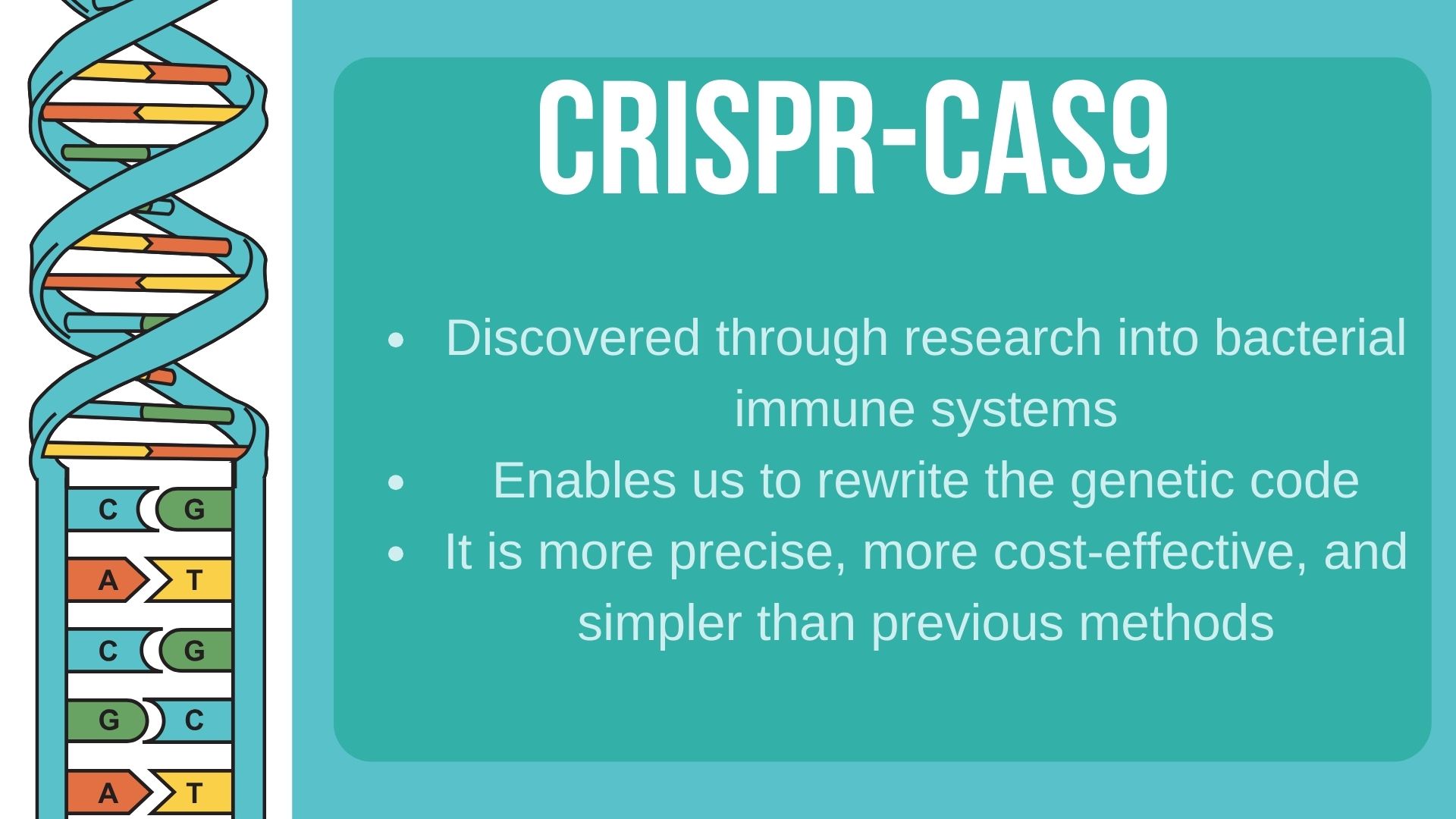What Is CRISPR-Cas9?

CRISPR stands for Clustered Regularly Interspaced Short Palindromic Repeats. This is a part of bacterial immune systems that is able to cut DNA, and has in this case been repurposed as a tool for gene editing. It is directed by a customisable guide to precisely cut a target DNA sequence.
The system is composed of two parts: a CRISPR-associated (Cas) nuclease, which does the binding and cutting of the DNA, and a guide RNA sequence (gRNA), which guides the Cas nuclease to its target.
It was discovered through research into bacterial immune systems, in which it cuts the DNA of viruses, thus disabling them. Once the molecular mechanism for this DNA-cutting ability was pinpointed, it was then developed as a tool for editing genomes.
CRISPR is significant because it enables us to rewrite the genetic code for almost any organism. It is more precise, more cost-effective, and simpler than previous gene editing methods. It also has many real-world applications, from curing genetic diseases to growing crops that are resistant to drought.
There is an important role for medical professionals in mediating this discussion, educating the public and policymakers, and ensuring that technology progresses in a way that is ethical and beneficial for society.
How Does CRISPR-Cas9 Work?
The CRISPR system is the basis of how adaptive immunity operates in bacteria. It uses Cas nucleases, which are enzymes that are able to bind and build double-stranded breaks (DSBs) in DNA. When a bacterium is infected with a virus, it uses a Cas nuclease to cut off a piece of the viral DNA called a protospacer.
The fragment is stored within the bacterial genome along with fragments from previous viruses that have infected the cell forming an immune memory. These virus spacer fragments are placed in between repeated palindromic sequences. It is this sequence of spacers and palindromic repeats that gives CRISPR its name.
When reinfected with the same virus in the future, the bacterium is able to recognise and destroy it using Cas9. Cas9 actions rely on a CRISPR RNA (crRNA) and also a trans-activating CRISPR RNA (tracrRNA).
The crRNA is complementary to the viral spacer that was held after the original infection, and meanwhile the tracrRNA acts as a scaffold. Together, these two RNAs form a complex called a guide RNA (gRNA). It can be helpful to picture the Cas9 as scissors, and the gRNA as the hand that is guiding them to cut in the right place.
Prior to cutting, the Cas9 functions as a search tool and checks the viral DNA for the protospacer adjacent motif (PAM), which is a short sequence downstream of the target site. Once it has recognised PAM, Cas9 then checks the region upstream.
If it locates the target that has been provided by the gRNA, it will then make a double-stranded break (DSB). DSBs incapacitate viruses because viruses do not have DNA repair mechanisms of their own.
This has enabled a method for genetic manipulation. Scientists only need to provide a different guide RNA and Cas9 can create cuts at target sites in the DNA of any organism. CRISPR-Cas9 is a powerful genome editing technology and has a wide range of applications that are being explored.
Potential Applications of CRISPR-Cas9
Medical Therapeutics

One of the most significant applications is for breakthroughs in medical therapeutics. In particular, gene therapy for genetic disorders, including neurodegenerative disease, blood disorders, cancer, and genetic eye diseases. The first trial of a CRISPR cell therapy was carried out in 2019 and treated patients with sickle cell disease.
In 2021, there was a significant and promising CRISPR trial for transthyretin amyloidosis, a neurodegenerative disease. CRISPR is also demonstrating significant uses in potential cures for cancer such as generating chimeric antigen receptor (CAR) T cells, which is a form of immunotherapy to treat cancer. The T cells are taken from patients, engineered to express chimeric antigen receptors, and then are injected back into the body.
The receptors allow the T cells to target and destroy the particular type of cancer the patient has more effectively. There also exists the potential to treat conditions such as breast and ovarian cancer linked to BRCA mutations, Huntington’s disease, cystic fibrosis, and early-onset Alzheimer’s. To keep up to date in medical news, it is a good idea to check science news sites, blogs, and journals regularly.
Agriculture

Gene editing technology has great potential in agriculture, in particular to improve crops by making them drought-resistant, and also to make plants resistant to disease.
For example, researchers at the University of Berkeley and Innovative Genomics Institute partnered with Mars to develop disease-resistant cacao plants. CRISPR may also be applied for plant host resistance by directly targeting genes, mRNAs, and miRNAs of parasitic plants.
Biomedical Research

CRISPR gene editing has been a hugely significant development for stem cell research. CRISPR-Cas9 edited cells can be used in model organism development and to generate organoids, which are three-dimensional models of human organs grown in the laboratory.
They are better for studying disease than cell cultures as they give more of the complexity of real human organs so are able to accurately model disease progression and treatment response.
CRISPR is also used in functional genomics which is a drug discovery method used to explore links between genes and their effects and so explore potential drug targets. Genome editing means it is possible to delete or change genes in cells to better understand their roles in disease.
Ethical Considerations
Safety Concerns
One of the most significant concerns about using CRISPR gene editing is the risk of off-target DNA cutting, which happens when the molecular scissors alter the wrong section of the genome, causing unwanted or unexpected effects, and even adverse alteration to the genome.
There are also safety concerns related to the long-term consequences of CRISPR. For example, some studies have suggested CRISPR use may cause cells to lose their ability to fight cancer.
Moral Implications
In addition to the safety risks, human genome editing raises ethical questions and questions of risk, both individual and societal. For some, the technology offers hope of editing mutations out of the gene pool.
For others, another way for the privileged to widen the gap between themselves and other. These are major questions in medical ethics. An open question remains where to draw the line between disease treatment and enhancement, bearing in mind differing attitudes toward conditions such as deafness.
The moral debate around gene editing in humans has focused on germline modifications, which also alter future generations’ DNA. A frequent concern is the potential for creating “designer babies”. The world’s first gene-edited babies were born in China in 2018, and the scientist responsible was jailed, following global public backlash.
Regulatory and Legal Issues

In most national contexts, anything made using CRISPR/Cas gene editing technology is subject to regulation and generally, though not in every case, follows whatever policies are in place around genetically modified organisms (GMOs) in that country. The European Union has already begun to include CRISPR within their GMO regulatory structure.
Internationally, the policy space relating to use of CRISPR in humans is voluminous and unevenly distributed globally. There is no global consensus on the use of CRISPR in humans in pre-clinical and clinical settings.
So far, only guidelines exist for the vast majority of policy prescriptions for applying CRISPR to humans, such as those put out by the World Health Organization or the National Academies of Science. These provide a foundation for regulation but are difficult to enforce, particularly across international boundaries.
The Role of Medical Professionals

Medical professionals and those aspiring to work in the field have an important role engaging with this technology and communicating with the public and policymakers. Part of this role is education, sharing facts about this technology and its uses in an objective way to improve public and policymaker understanding. Medical professionals are also expected to understand and respond to the ethical concerns and debates taking place.
On issues such as “designer babies”, fundamental values are involved and the public expect those working in medicine to earn their trust by listening to their concerns and having these reflected in practice and in regulation.
Researchers are continually finding novel ways of applying this technology to solve significant problems in the world, including epigenome editing, new cell and gene therapies, disease research, and in agriculture. Medical professionals must stay informed about advancements and implications in this rapidly advancing field.
